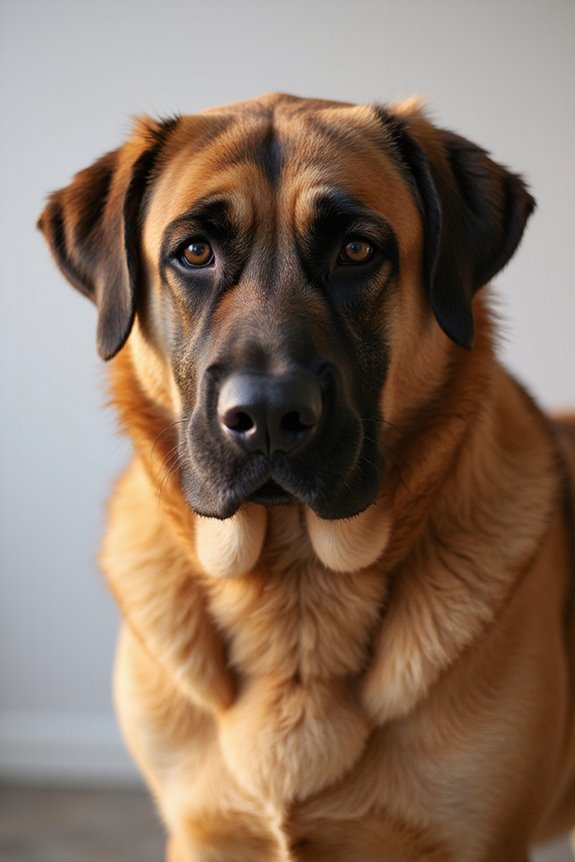Caring for giant breeds involves specific attention to their unique needs. You should guarantee a balanced diet, addressing caloric intake and maintaining the ideal calcium-to-phosphorus ratio. Regular veterinary check-ups are essential for managing health risks. Joint and skeletal health require monitoring and potentially supplements for cartilage support. Exercise must be controlled to protect developing joints, while early socialization enhances behavior. Creating a safe living environment is critical. By understanding these factors, you’ll guarantee their well-being throughout their life.
Key Takeaways
- Provide a balanced diet with the appropriate calcium-to-phosphorus ratio for optimal bone health and growth.
- Monitor caloric intake to prevent obesity; feed measured meals 2 to 4 times daily instead of free feeding.
- Regular veterinary check-ups every 2 to 4 weeks are essential to monitor health and prevent conditions common in giant breeds.
- Engage in low-impact exercises, like controlled walks and swimming, to promote joint health and prevent injury.
- Ensure early socialization and positive reinforcement training to promote good behavior and adaptability in various environments.
Nutritional Requirements for Giant Breed Puppies
When it comes to the nutritional requirements for giant breed puppies, understanding their unique needs is essential for promoting healthy growth and development. Caloric balance is critical; these puppies require a careful intake of calories to prevent rapid growth and obesity. During the first four months, their calorie demands soar due to rapid tissue development.
Key points to take into account:
- Balance protein, fat, and carbohydrates for ideal growth.
- Monitor mineral ratios, especially calcium-to-phosphorus, ideally between 1.1:1 and 1.4:1, to promote healthy bone development.
- Implement portion-controlled feeding with 2 to 4 measured meals per day, avoiding free feeding to better manage weight.
Veterinary Care and Preventative Measures
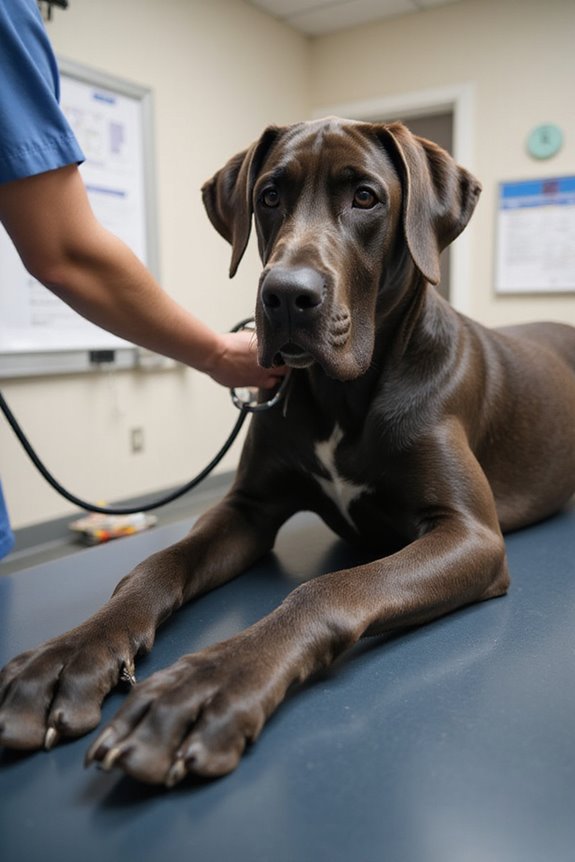
Veterinary care for giant breed dogs plays a critical role in their overall health and longevity, especially when combined with a well-structured nutritional plan. Regular check-ups are essential; I schedule visits every 2 to 4 weeks for my puppies, shifting to semi-annual appointments for seniors over five. These routine wellness exams include thorough evaluations—eyes, ears, heart, and more—to catch potential issues early.
I’m diligent about following vaccination schedules, starting with core vaccines. Monthly preventatives for parasites are a must due to their size.
Additionally, I keep detailed records of each visit, noting questions on preventative screenings and vaccination protocols tailored to giant breeds’ specific health needs. Maintaining this routine fosters a long, healthy life for my beloved companion.
Ensuring Joint and Skeletal Health
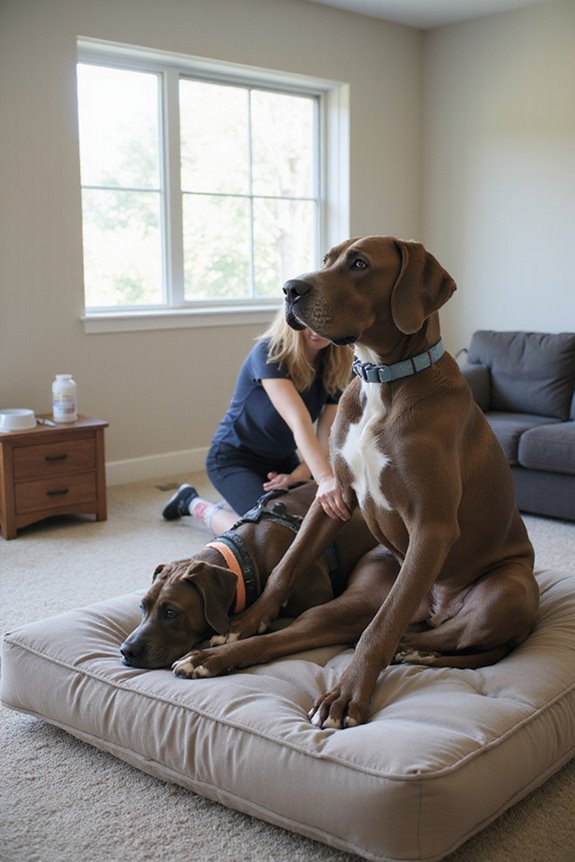
Guaranteeing joint and skeletal health is paramount for giant breed dogs, as their size and weight make them particularly susceptible to various joint conditions. It’s essential to monitor their growth and provide a balanced diet, rich in calcium and omega-3 fatty acids, to support bone and joint health. I often recommend joint supplements like glucosamine and chondroitin to aid cartilage repair and lubrication. Additionally, regular use of joint supplements can lead to improved mobility and comfort, further enhancing their quality of life.
In addition to nutritional support, regular low-impact exercise, such as swimming or controlled walks, helps maintain mobility without undue strain.
Utilizing mobility aids, like ramps or joint braces, can also help ease their daily movements and prevent further injury. Ultimately, a collaborative approach involving veterinary care and preventive measures can guarantee their long-term joint health and quality of life.
Grooming Needs and Coat Care
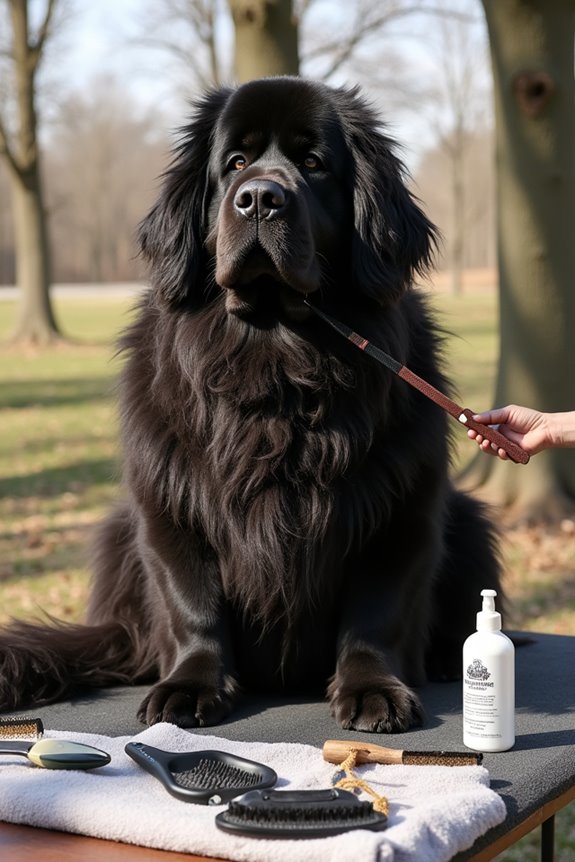
Maintaining a well-groomed coat is vital for giant breed dogs, not just for their appearance but also for their overall health. Regular grooming prevents matting and keeps their coat clean. I recommend establishing a grooming schedule using effective grooming tools, such as slicker brushes and wide-toothed combs, focusing on areas prone to tangles. For extensive coats, daily brushing can enhance shine and reduce shedding.
Additionally, bathing every 6-8 weeks with a mild shampoo, coupled with a proper drying technique, is essential. I also suggest trimming nails every 2-3 weeks to prevent discomfort. Regular ear inspections and cleaning will help avoid infections, ensuring your giant breed enjoys ideal health and comfort. To maximize effectiveness, choose grooming tools that are compatible with your dog’s coat type.
Exercise and Physical Activity Guidelines
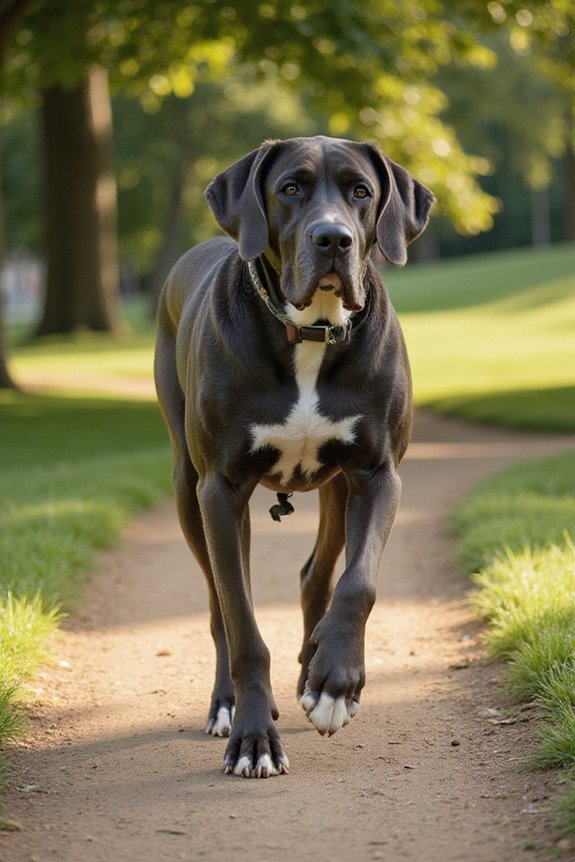
When it comes to exercise and physical activity, it’s essential to tailor a regimen that suits the unique needs of giant breed dogs. Start with about 45 minutes to 2 hours of daily activity, divided into shorter sessions like three 20-minute walks to manage joint stress.
Consider the following guidelines:
- Exercise Intensity: For puppies, control activity to protect developing joints, while seniors need gentler, shorter sessions.
- Activity Variety: Incorporate controlled walking, limited running, swimming, and mental engagement through training exercises.
Varying surfaces, such as grass or sand, can reduce joint wear. Always monitor your dog for signs of fatigue, and guarantee consistent exercise to prevent obesity, a significant joint risk factor for giant breeds.
Managing Life Stages of Giant Breeds
Managing the life stages of giant breeds requires an understanding of their unique developmental needs, as each phase presents distinct challenges and considerations.
Growth Stages
- Early Puppyhood: Birth to 2 months focuses on foundational growth.
- Rapid Growth Stage: 2 to 6 months sees accelerated size and weight gains.
- Slowing Growth Stage: 6 to 12 months shifts to gradual size increase and joint health.
Adolescence Challenges
This phase lasts from 18 months to 3 years, with significant hormonal changes and energy surges. During this time, it’s essential to establish proper training and socialization to prevent behavioral issues.
Nutritional needs shift from growth-focused to maintenance, emphasizing balanced diets that support joint and overall health. Regular veterinary check-ups are important to monitor growth and behavioral development.
Importance of Weight Management
Weight management is essential for the long-term health and well-being of giant breeds, as their unique physical characteristics make them particularly susceptible to weight-related complications. Proper caloric monitoring plays a significant role in obesity prevention. Here are some key points to evaluate:
- Daily Energy Needs: Giant breeds require more daily energy but fewer calories per pound compared to smaller dogs.
- Balanced Diet: Choose diets specifically formulated for giant breeds to support slower growth, ensuring a balanced intake of calcium and phosphorus.
- Scheduled Feeding: Avoid free-feeding and implement scheduled meals to monitor intake effectively.
- Regular Exercise: Encourage moderate daily activity, as it supports muscle retention and appetite regulation. Additionally, selecting high-quality ingredients in their diet is crucial to ensure they receive the necessary nutrients for optimal growth and health.
Addressing Common Health Concerns
Addressing the common health concerns associated with giant breeds is critical, as these large dogs face unique challenges that can greatly impact their quality of life. Regular health screenings are important given their predisposition to conditions like hip dysplasia, degenerative joint disease, and gastric dilatation volvulus (GDV). Monitoring for signs of cardiovascular issues, like dilated cardiomyopathy, and being vigilant about possible cancers, especially osteosarcoma, is significant.
In addition to physical health, behavioral issues can arise from pain or discomfort, so staying attuned to changes in your dog’s behavior is key. Incorporating a preventative healthcare plan, with frequent check-ups, tailored nutrition, and early intervention, can help guarantee your giant breed lives a healthy, fulfilling life.
Creating a Comfortable Living Environment
Creating a comfortable living environment for giant breeds requires careful consideration of their unique needs and challenges.
Space Optimization
Your home should provide ample room for your dog to move freely. This means having enough space for large beds, feeding stations, and toys without risking injury from bumping into furniture. An open floor plan often works best. Additionally, elevated dog beds can be beneficial for larger breeds, providing support and comfort.
Indoor Safety
Keep fragile items out of your dog’s reach to avoid accidents. Use non-slip surfaces to reduce the risk of falls. Additionally, consider placing orthopedic beds in quiet, draft-free areas.
Frequently Asked Questions
What Are Ideal Companion Breeds for Giant Dogs?
When I think about ideal playmates for giant dogs, breed compatibility is key. Breeds like Bernese Mountain Dogs and Mastiffs blend beautifully with their gentle nature, ensuring joyful playtime while keeping things safe and harmonious.
How Much Space Do Giant Breeds Need to Thrive?
When I had my Great Dane, Sparky, I found he thrived with ample space for outdoor activities. He needed room to run and play, meeting his exercise requirements, which kept him happy and healthy.
What Are Common Behavioral Issues in Giant Breeds?
I’ve noticed giant breeds often experience anxiety management challenges, like fear-related aggression triggers or separation anxiety. These behaviors can intensify without proper support, so it’s essential to address any signs of distress early on.
Can Giant Breeds Adapt to Apartment Living?
Sure, giant breeds can adapt to apartment living, but it’s essential to address apartment challenges. I’ve found that understanding giant breed considerations, like exercise and space management, makes all the difference for our furry friends.
What Emergency First Aid Should I Know for Giant Breeds?
Ever wondered what first aid you should know for giant breeds? I’ve learned it’s essential to keep emergency supplies nearby, like gauze and antiseptics, and to understand their specific needs in emergencies for effective care.


